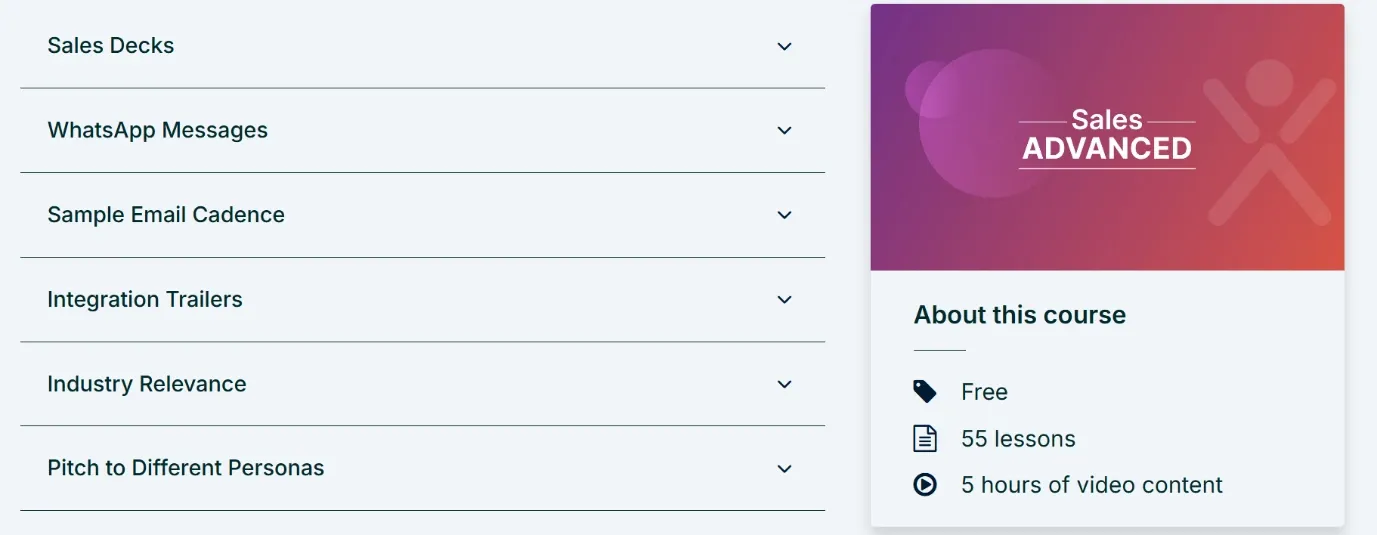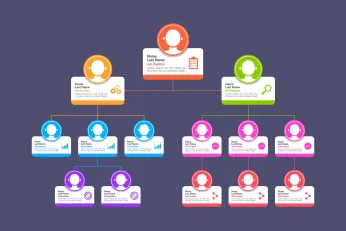10 Langkah Menuju Rencana Penerimaan Penjualan yang Sukses
Rencana orientasi penjualan yang terstruktur dengan baik akan meningkatkan retensi dan produktivitas. Ikuti langkah-langkah penting ini untuk memastikan karyawan penjualan baru siap, percaya diri, dan siap berkontribusi sejak hari pertama.
Di halaman ini
Menyambut karyawan penjualan baru ke dalam tim Anda adalah momen penting yang menentukan kesuksesan mereka dan pertumbuhan perusahaan Anda. Rencana orientasi penjualan yang terstruktur dengan baik memastikan karyawan baru merasa siap, percaya diri, dan siap untuk berkontribusi pada tujuan tim. Faktanya, perusahaan dengan proses orientasi penjualan yang kuat meningkatkan retensi karyawan baru sebesar 82% dan produktivitas lebih dari 70%(Sumber:Glassdoor).
Dalam blog ini, kami akan memberikan panduan komprehensif untuk membuat rencana orientasi penjualan yang sukses. Panduan ini akan membahas komponen penting, praktik terbaik, dan strategi untuk memastikan anggota tim penjualan baru Anda dapat langsung bekerja dengan baik.
Kita akan membahas elemen-elemen kunci dari rencana orientasi penjualan, cara membuat program yang efektif, cara mengukur keberhasilannya, dan praktik terbaik untuk mengatasi tantangan-tantangan umum. Di akhir blog ini, Anda akan dibekali dengan pengetahuan untuk merancang rencana orientasi yang kuat yang menyiapkan tim penjualan Anda untuk kesuksesan jangka panjang.
Apa yang dimaksud dengan orientasi penjualan?
Orientasi penjualan adalah proses mengintegrasikan karyawan penjualan baru ke dalam organisasi Anda dan membekali mereka dengan pengetahuan, keterampilan, dan alat yang diperlukan untuk menjalankan peran mereka secara efektif. Proses ini lebih dari sekadar pelatihan awal dan mencakup dukungan berkelanjutan untuk memastikan karyawan baru menjadi anggota tim yang produktif.
Orientasi yang efektif sangat penting bagi karyawan penjualan baru karena hal ini akan menentukan masa kerja mereka di perusahaan. MenurutSHRMperusahaan yang memiliki proses orientasi formal mengalami produktivitas karyawan baru 50% lebih besar.
Rencana orientasi yang terstruktur membantu karyawan baru memahami peran mereka, membangun kepercayaan diri, dan merasa terhubung dengan misi dan nilai-nilai perusahaan.
Rencana orientasi penjualan yang dijalankan dengan baik dapat secara signifikan memengaruhi kinerja dan retensi. Penelitian oleh Aberdeen Group menunjukkan bahwa62% perusahaanyang memiliki program orientasi khusus melihat waktu yang lebih cepat untuk mencapai produktivitas. Selain itu, organisasi yang berinvestasi dalam proses orientasi mengalami peningkatan keterlibatan karyawan sebesar 54%, yang berujung pada tingkat retensi yang lebih tinggi.
Manfaat dari proses orientasi penjualan yang efektif
Rencana orientasi penjualan yang terstruktur dengan baik memastikan bahwa karyawan baru mendapatkan pemahaman yang mendalam tentang tanggung jawab mereka, yang mengarah pada peningkatan produktivitas, retensi yang lebih tinggi, dan keterlibatan yang lebih kuat. Perusahaan yang memprioritaskan rencana pelatihan orientasi penjualan yang efektif akan mendapatkan beberapa manfaat utama:
Waktu peningkatan yang lebih cepat dan produktivitas yang lebih baik
Proses orientasi yang dioptimalkan membantu tenaga penjualan menjadi lebih cepat produktif, sehingga mengurangi waktu yang dibutuhkan untuk berkontribusi secara bermakna. Efisiensi ini memungkinkan perusahaan untuk memenuhi target pendapatan secara lebih konsisten.
Persentase yang lebih tinggi dari repetisi yang mencapai kuota
Menyediakan alat, sumber daya, dan pengetahuan yang tepat bagi para staf penjualan akan meningkatkan kemampuan mereka untuk memenuhi dan melampaui target penjualan. Rencana pelatihan orientasi penjualan yang dirancang dengan baik memastikan mereka siap untuk sukses sejak hari pertama.
Perputaran karyawan yang lebih rendah dan hasil rekrutmen yang lebih baik
Pengalaman orientasi yang positif akan menghasilkan kepuasan kerja yang lebih tinggi, sehingga mengurangi kemungkinan karyawan untuk mencari peluang di tempat lain. Hal ini tidak hanya meningkatkan retensi, tetapi juga memperkuat kemampuan perusahaan untuk menarik talenta terbaik.
Peningkatan kepuasan dan keterlibatan perwakilan
Ketika para perwakilan merasa dibekali dengan keterampilan dan pengetahuan yang diperlukan, mereka lebih percaya diri, terlibat, dan berkomitmen terhadap peran mereka - menghasilkan tim penjualan yang lebih termotivasi dan berkinerja tinggi.
Agar proses orientasi benar-benar efektif, proses ini harus menarik, mudah diikuti, dan dirancang untuk memperkuat pembelajaran dengan berbagai cara. Rencana orientasi penjualan yang dinamis dan terstruktur dengan baik akan menjadi fondasi kesuksesan jangka panjang, yang bermanfaat bagi perwakilan individu dan organisasi secara keseluruhan.
Contoh program orientasi penjualan yang efektif
Ambil Xoxoday sebagai contoh. Berikut ini adalah kisah sukses untuk program orientasi penjualan yang efektif:
1. Xoxoday:

Xoxoday telah mengembangkan program orientasi yang terstruktur dan efektif untuk Sales Development Representative (SDR) baru yang berfokus pada pembelajaran berkelanjutan, pengalaman langsung, dan lingkungan pelatihan yang mendukung.
Elemen Kunci:
- Program Pelatihan Komprehensif: Setelah seorang SDR dipekerjakan, mereka mendapatkan akses ke XoxoAcademy, yang memberikan pengenalan menyeluruh terhadap produk. Mereka diharuskan menyelesaikan berbagai kursus dan tugas untuk membangun pengetahuan produk mereka. Setelah selesai, seorang anggota senior menilai pemahaman mereka tentang produk, dan mereka juga mendapatkan sertifikat penyelesaian kursus.
- Jalur Pembelajaran Terpandu: Untuk mempersiapkan SDR untuk semua jenis pertemuan, mereka diberikan dokumen kasus penggunaan untuk penilaian. Mereka juga mendapat manfaat dari rencana pembelajaran dan pengembangan (L&D) terstruktur, yang mencakup peluang pembelajaran berkelanjutan di XoxoAcademy.
- Bimbingan dan Dukungan Awal:SDR menerima bimbingan dan dukungan awal untuk membantu mereka bertransisi dengan lancar. Panduan ini membangun kepercayaan diri dan kesiapan untuk berinteraksi dengan pelanggan. Interaksi semacam itu membantu SDR merasa lebih siap dan didukung sejak awal.
- Pengalaman Praktis: SDR baru diwajibkan untuk melakukan demo uji coba untuk menunjukkan pemahaman mereka terhadap produk. Setelah menerima persetujuan dari manajer mereka, mereka melanjutkan ke panggilan demo langsung, yang memungkinkan mereka untuk menerapkan pelatihan mereka dalam situasi dunia nyata.
XoxodayProses orientasi menumbuhkan lingkungan yang mendukung bagi SDR, yang mengarah pada orientasi yang lebih cepat, keterlibatan karyawan yang lebih besar, dan peningkatan kinerja. Dengan berinvestasi pada karyawan baru mereka sejak awal, Xoxoday menumbuhkan tim penjualan yang berpengetahuan dan termotivasi.
Komponen utama dari rencana orientasi penjualan
Berikut ini adalah komponen utama dari rencana penerimaan penjualan:
1. Pra-penerbangan: Menetapkan ekspektasi dan mempersiapkan diri untuk hari pertama
Sebelum tanggal mulai kerja, pastikan karyawan baru memiliki semua informasi dan materi yang diperlukan. Hal ini termasuk mengirimkan email selamat datang, menyediakan akses ke sistem yang diperlukan, dan membagikan garis besar jadwal orientasi.
Menurut sebuah studi olehCareerBuilder36% perusahaan tidak memiliki proses orientasi terstruktur, menyoroti pentingnya orientasi awal untuk mengatur suasana yang tepat.
2. Sambutan dan orientasi: Memperkenalkan budaya dan nilai-nilai perusahaan
Beberapa hari pertama harus didedikasikan untuk memperkenalkan karyawan baru pada budaya, nilai, dan misi perusahaan. Hal ini membantu mereka memahami gambaran yang lebih besar dan bagaimana peran mereka berkontribusi terhadap tujuan bisnis secara keseluruhan. Sebuah studi oleh BambooHR menemukan bahwa karyawan yang memiliki pengalaman orientasi yang positif memiliki kemungkinan 18 kali lebih besar untuk merasa berkomitmen tinggi terhadap organisasi mereka.
3. Pelatihan produk: mendalami produk/layanan
Pelatihan produk yang komprehensif sangat penting untuk memastikan tenaga penjualan baru memiliki pemahaman menyeluruh tentang apa yang mereka jual. Hal ini harus mencakup fitur produk, manfaat, dan nilai jual yang unik, serta analisis pesaing.
4. Pelatihan proses penjualan: Memahami siklus dan metodologi penjualan
Pelatihan mengenaiproses penjualan perusahaan, termasuk menghasilkan prospek, mencari prospek, melakukan kualifikasi, presentasi, dan penutupan, sangatlah penting. Ini juga termasuk membiasakan karyawan baru dengan metodologi dan teknik penjualan yang digunakan perusahaan Anda.
5. Alat dan sumber daya: Pemahaman tentang CRM dan alat penjualan
Karyawan baru harus dilatih tentang alat dan sumber daya yang akan mereka gunakan setiap hari, seperti sistem CRM, alat otomasi penjualan, dan platform komunikasi. Memastikan mereka merasa nyaman dengan alat bantu ini akan membantu mereka mengelola alur kerja secara efisien.
6. Pelatihan khusus untuk peran tertentu: Menyesuaikan pelatihan untuk peran penjualan yang berbeda
Setiap peran penjualan mungkin memiliki persyaratan dan tanggung jawab yang spesifik. Menyesuaikan pelatihan untuk menangani nuansa ini memastikan bahwa setiap anggota tim dipersiapkan dengan baik untuk peran spesifik mereka.
Agar rencana pelatihan orientasi penjualan menjadi efektif, rencana tersebut harus selaras dengan ekspektasi kinerja, mengintegrasikan aktivitas dunia nyata, dan mudah diakses dalam alur kerja. Ikuti langkah-langkah berikut untuk membuat program orientasi yang sukses:
Daftar periksa orientasi penjualan wajib
Berikut ini adalah daftar periksa orientasi penjualan wajib yang harus Anda perhatikan:
1. Mengukur kinerja dasar
Sebelum merancang rencana orientasi penjualan, evaluasi metrik kinerja saat ini untuk menetapkan garis dasar. Pertimbangkan:
- Berapa lama waktu yang dibutuhkan oleh account executive (AE) baru untuk memenuhi kuota mereka?
- Berapa tingkat konversi dari Tahap 1 ke Tahap 2 untuk repetisi baru?
- Berapa lama waktu yang dibutuhkan oleh perwakilan pengembangan bisnis (BDR) untuk menjadwalkan janji temu pertama mereka?
- Seberapa cepat seorang AE menutup transaksi pertama mereka?
Melacak metrik ini akan membantu mengukur dampak rencana pelatihan orientasi penjualan Anda terhadap kinerja bisnis. Semakin tepat data dasar Anda, semakin baik Anda dapat menyesuaikan program dan menunjukkan dampaknya terhadap pertumbuhan pendapatan.
2. Tentukan ekspektasi kinerja
Orientasi yang efektif dimulai dengan tujuan kinerja yang jelas dan terukur. Tanyakan pada diri Anda sendiri:
- Tugas apa yang harus dilakukan oleh seorang tenaga penjual dalam pekerjaannya?
- Bagaimana kemajuan mereka akan diukur?
Jika membangun dari nol, tetapkan tonggak-tonggak penting yang menentukan keberhasilan. Sebagai contoh:
- BDR harus berhasil menjadwalkan lima janji temu yang memenuhi syarat dalam jangka waktu tertentu.
- Seorang AE harus melakukan delapan demo, dengan setidaknya empat demo yang berlanjut ke tahap penjualan berikutnya.
Setiap tonggak sejarah berkontribusi pada pencapaian pendapatan dan kuota aktivitas, menetapkan jalur yang jelas menuju kesuksesan.
3. Menetapkan garis waktu
Setelah Anda menentukan hasil yang diharapkan, susunlah ke dalam beberapa fase. Banyak perusahaan mengadopsi kerangka kerja 30-60-90 hari, tetapi ini harus disesuaikan dengan siklus bisnis dan penjualan Anda.
Misalnya, jika siklus penjualan Anda adalah 30 hari, bagilah orientasi menjadi tiga fase 10 hari, yang masing-masing mengarah pada pencapaian tertentu. Pastikan karyawan baru belajar sambil berinteraksi dengan pelanggan, mengintegrasikan pelatihan dengan tugas harian mereka.
Menyesuaikan kerangka waktu memastikan bahwa karyawan baru mencapai pencapaian yang tepat dalam jadwal yang sesuai dengan kebutuhan bisnis Anda.
4. Mengidentifikasi kegiatan untuk setiap tonggak pencapaian
Tentukan kegiatan utama yang diperlukan untuk mencapai setiap hasil. Karena beberapa langkah sering kali berkontribusi pada sebuah pencapaian, bagi langkah-langkah tersebut menjadi beberapa komponen yang dapat ditindaklanjuti.
Berkolaborasi dengan para manajer dan karyawan terbaik untuk menguraikan langkah-langkah ini. Perwakilan yang berpengalaman dapat memberikan wawasan yang berharga dan membantu memperjuangkan program ini setelah diimplementasikan.
5. Mengatur kegiatan dalam urutan yang logis
Beberapa hasil akan memiliki urutan yang jelas, sementara yang lain mungkin perlu disempurnakan. Fokuslah pada penyusunan kegiatan secara logis daripada menyajikan informasi yang berlebihan di awal.
Beberapa perusahaan menggunakan dokumen seperti Word atau Google Docs untuk memetakan aktivitas, sementara perusahaan lain lebih memilih spreadsheet untuk pelacakan terstruktur.
6. Mengidentifikasi pengetahuan yang penting untuk sukses
Setiap aktivitas membutuhkan dasar pengetahuan. Misalnya, jika BDR perlu menjadwalkan janji temu yang memenuhi syarat, mereka harus memahami:
- Persona pembeli utama
- Titik sakit dan motivasi yang umum terjadi
- Teknik penjangkauan yang efektif
Pastikan materi pelatihan memberikan konteks yang diperlukan bagi karyawan baru untuk melaksanakan tugas dengan percaya diri.
7. Menetapkan pos pemeriksaan kinerja
Setiap tonggak pencapaian harus menyertakan pos pemeriksaan kinerja untuk melacak kemajuan dan memberikan dukungan jika diperlukan. Pos pemeriksaan ini dapat mencakup:
- Sertifikasi demo
- Praktik penyampaian pesan yang bernilai dengan umpan balik
- Sesi mendengarkan dan pembinaan panggilan
- Ulasan saluran pipa
- Latihan bermain peran
Dengan menilai kemajuan secara teratur, manajer dapat memastikan bahwa karyawan baru menerima panduan yang diperlukan untuk berhasil.
8. Membangun program orientasi Anda
Dengan elemen-elemen dasar yang sudah ada, mulailah menyusun rencana orientasi penjualan Anda. Pertimbangkan setiap tonggak pencapaian sebagai modul konten dan manfaatkan sumber daya yang ada jika memungkinkan untuk menghindari duplikasi.
Jika waktu atau sumber daya terbatas, prioritaskan pengembangan komponen yang berdampak paling besar terlebih dahulu, kemudian kembangkan secara bertahap.
Sekarang, setelah Anda mengetahui apa yang perlu Anda lakukan, berikut ini adalah templat untuk Anda.
Templat rencana penerimaan penjualan
Berikut ini adalah satu-satunya templat rencana penerimaan penjualan yang Anda perlukan.
Mulai sebelum hari pertama
- Kirimkan email selamat datang dengan detail awal, kontak POC, jadwal, dan sumber daya utama.
- Pastikan transisi yang lancar dengan rencana orientasi penjualan yang terstruktur.
Minggu pertama
- Perkenalkan nilai-nilai, budaya, kebijakan, dan fasilitas perusahaan.
- Jelaskan ekspektasi dan berikan bagan organisasi.
- Jadwalkan pertemuan dengan manajer penjualan, anggota tim, dan mentor.
- Lakukan demo produk dan berikan akses ke CRM dan alat penjualan.
- Mintalah perwakilan mengamati panggilan pelanggan untuk mendapatkan wawasan.
- Mengatur pelatihan CRM (1) dengan penilaian.
- Libatkan perwakilan dalam latihan, diskusi, dan bermain peran.
30 hari pertama
- Menyediakan pelatihan produk dan layanan + pelatihan CRM (2).
- Membutuhkan bayangan rekan penjualan dalam panggilan/rapat.
- Jelaskan persona pembeli dan proses penjualan.
- Melakukan negosiasi dan praktik penanganan keberatan.
- Mintalah perwakilan untuk mendengarkan panggilan penemuan dan berpartisipasi dalam panggilan tiruan.
- Pastikan perwakilan menyempurnakan elevator pitch mereka dan mengirimkannya.
- Mintalah perwakilan untuk melakukan panggilan penjualan independen dan mengidentifikasi peluang.
- Jadwalkan pemeriksaan rutin untuk penilaian dan dukungan kompetensi.
Setelah 30 hari
- Mintalah pemimpin penjualan untuk meninjau panggilan telepon dari perwakilan dan memberikan umpan balik.
- Tentukan tujuan jangka panjang untuk pertumbuhan karier.
- Lanjutkan pemeriksaan rutin untuk mendapatkan dukungan yang berkelanjutan.
- Kumpulkan umpan balik untuk meningkatkan templat rencana penerimaan penjualan.
Rencana pelatihan orientasi penjualan yang terstruktur akan mempercepat kesuksesan dan pengembangan karier.
Bagaimana cara membuat rencana orientasi penjualan yang efektif?
Cara untuk membuat rencana orientasi penjualan yang efektif:
Langkah 1: Menetapkan tujuan dan sasaran yang jelas
Tentukan seperti apa kesuksesan karyawan baru selama proses orientasi. Tetapkan tujuan dan sasaran yang jelas dan terukur yang selaras dengan metrik kinerja individu dan perusahaan.
Menurut Society for Human Resource Management (SHRM), menetapkan ekspektasi yang jelas sejak awal dapat meningkatkan kepercayaan diri dan produktivitas karyawan baru.
Langkah 2: Mengembangkan garis waktu dan pencapaian yang terstruktur
Buat jadwal orientasi terperinci yang menguraikan setiap fase proses pelatihan. Jadwal ini harus mencakup tonggak-tonggak penting seperti menyelesaikan pelatihan produk, menguasai CRM, dan mencapai target penjualan pertama.
Pendekatan terstruktur membantu karyawan baru untuk tetap berada di jalur yang benar dan memastikan mereka berkembang seperti yang diharapkan.
Langkah 3: Menugaskan mentor dan teman untuk mendapatkan dukungan
Memasangkan karyawan baru dengan mentor atau teman yang berpengalaman dapat memberikan dukungan dan panduan yang berharga. Hubungan ini membantu anggota tim baru untuk menyesuaikan diri lebih cepat, mempelajari praktik terbaik, dan merasa lebih terhubung dengan tim.
Penelitian oleh SAP SuccessFactors menunjukkan bahwa karyawan baru yang memiliki mentor lebih mungkin untuk bertahan lebih lama di perusahaan.
Langkah 4: Memasukkan praktik langsung dan bermain peran
Pelatihan praktis melalui latihan langsung dan skenario bermain peran sangat penting untuk mengembangkan keterampilan penjualan. Hal ini memungkinkan karyawan baru untuk mempraktikkan situasi kehidupan nyata, menerima umpan balik, dan membangun kepercayaan diri dalam kemampuan mereka.
Langkah 5: Pembelajaran dan pengembangan berkelanjutan: lokakarya, webinar, dan e-learning
Orientasi penjualan tidak boleh berhenti setelah periode pelatihan awal. Kesempatan belajar berkelanjutan, seperti lokakarya, webinar, dan modul e-learning, memastikan bahwa tenaga penjualan tetap mendapatkan informasi terbaru tentang tren industri dan menyempurnakan keterampilan mereka. Program pengembangan berkelanjutan telah terbukti meningkatkan produktivitas dan keterlibatan jangka panjang.
Bagaimana cara mengukur keberhasilan rencana orientasi penjualan Anda?
Cara untuk mengukur keberhasilan rencana orientasi penjualan Anda:
1. Metrik utama untuk melacak waktu menuju penjualan pertama, waktu peningkatan, tingkat retensi
- Waktu untuk Penjualan Pertama: Ukur berapa lama waktu yang dibutuhkan karyawan baru untuk melakukan penjualan pertama mereka. Waktu yang lebih singkat untuk penjualan pertama menunjukkan orientasi yang efektif.
- Waktu Peningkatan: Lacak waktu yang dibutuhkan karyawan baru untuk mencapai produktivitas penuh. Tolok ukur industri dapat membantu menilai apakah proses orientasi Anda sudah efisien.
- Tingkat Retensi: Pantau tingkat retensi karyawan baru. Tingkat retensi yang tinggi sering kali mencerminkan pengalaman orientasi yang positif.
2. Mengumpulkan umpan balik dari karyawan dan manajer baru
Kumpulkan umpan balik secara teratur dari karyawan baru dan manajer mereka untuk mengidentifikasi kekuatan dan area yang perlu ditingkatkan dalam proses orientasi. Hal ini dapat dilakukan melalui survei, wawancara, atau pemeriksaan informal. MenurutGalluporganisasi yang bertindak berdasarkan umpan balik dari karyawan mengalami peningkatan profitabilitas sebesar 21%.
3. Memperbarui dan meningkatkan rencana orientasi secara teratur
Terus menyempurnakan rencana orientasi berdasarkan umpan balik dan metrik kinerja. Terus ikuti perkembangan praktik terbaik industri dan gunakan metode dan alat bantu pelatihan yang baru. Proses orientasi yang adaptif memastikan proses ini tetap relevan dan efektif dari waktu ke waktu.
Praktik-praktik terbaik untuk orientasi penjualan
4 Praktik terbaik untuk orientasi penjualan:
1. Mempersonalisasi pengalaman orientasi
Sesuaikan proses orientasi untuk memenuhi kebutuhan dan latar belakang karyawan baru yang unik. Orientasi yang dipersonalisasi dapat mencakup materi pelatihan yang disesuaikan, konten khusus peran, dan jalur pembelajaran individu. Pengalaman yang dipersonalisasi dapat meningkatkan keterlibatan dan membuat karyawan baru merasa dihargai.
2. Mendorong kolaborasi dan pembangunan tim
Memfasilitasi kesempatan bagi karyawan baru untuk berkolaborasi dengan rekan-rekan mereka dan membangun hubungan di dalam tim. Aktivitas pembangunan tim, proyek kelompok, dan acara sosial dapat membantu karyawan baru merasa terintegrasi dan menjadi bagian dari tim. Tim yang kohesif dapat menghasilkan komunikasi yang lebih baik dan kinerja yang lebih tinggi.
3. Menyediakan pemeriksaan rutin dan tinjauan kinerja
Jadwalkan pemeriksaan rutin dan tinjauan kinerja selama masa orientasi. Titik-titik kontak ini memungkinkan manajer untuk memberikan umpan balik yang konstruktif, mengatasi masalah, dan menawarkan dukungan.
Menurut sebuah studi olehForbes89% pemimpin SDM setuju bahwa umpan balik dari rekan kerja yang berkelanjutan dan check-in merupakan kunci pengembangan dan kepuasan karyawan.
4. Menawarkan insentif dan pengakuan atas pencapaian yang diraih
Kenali dan berikan penghargaan kepada karyawan baru yang telah mencapai pencapaian penting selama masa orientasi. Insentif seperti bonus, sertifikat, atau pengakuan publik dapat memotivasi karyawan baru untuk mencapai tujuan mereka dan merasa dihargai. Pengakuan dapat meningkatkan semangat kerja dan mendorong sikap positif terhadap proses orientasi.
Tantangan umum dalam orientasi penjualan dan cara mengatasinya
Tantangan umum dalam orientasi penjualan dan cara mengatasinya:
1. 1. Menangani informasi yang berlebihan
- Tantangan: Karyawan baru sering kali menghadapi banjir informasi, yang dapat membuat mereka kewalahan dan kontraproduktif.
- Solusi: Pisahkan konten orientasi menjadi beberapa bagian yang mudah dikelola dan prioritaskan informasi yang paling penting terlebih dahulu. Gunakan berbagai format pelatihan seperti video, modul interaktif, dan aktivitas langsung agar konten tetap menarik dan lebih mudah dicerna.
2. Memastikan konsistensi dalam pelatihan
- Tantangan: Pelatihan yang tidak konsisten dapat menyebabkan kesenjangan dalam pengetahuan dan keterampilan di antara karyawan baru.
- Solusi: Kembangkan kurikulum dan materi orientasi standar yang memastikan semua karyawan baru menerima informasi yang sama. Gunakan kombinasi pelatihan tatap muka dan online untuk menjaga konsistensi sekaligus memberikan fleksibilitas.
3. Mengatasi gaya belajar yang berbeda
- Tantangan: Karyawan baru memiliki preferensi pembelajaran yang beragam, sehingga sulit untuk membuat program orientasi yang cocok untuk semua orang.
- Solusi: Gabungkan berbagai metode pelatihan, termasuk pendekatan visual, pendengaran, dan kinestetik. Tawarkan modul e-learning yang dapat dipelajari secara mandiri di samping sesi pelatihan langsung untuk memenuhi gaya belajar yang berbeda.
4. Menjaga karyawan baru tetap terlibat dan termotivasi
- Tantangan: Mempertahankan keterlibatan dan motivasi selama proses orientasi bisa menjadi tantangan tersendiri, terutama untuk tim jarak jauh atau tim hybrid.
- Solusi: Jadikan proses orientasi interaktif dan menarik dengan memasukkan elemen gamifikasi, kuis, dan skenario kehidupan nyata. Secara teratur memeriksa karyawan baru untuk memberikan dukungan dan menjaga mereka tetap termotivasi. Aktivitas pembangunan tim virtual juga dapat membantu karyawan jarak jauh merasa terhubung.
Kesimpulan
Rencana orientasi penjualan yang dijalankan dengan baik lebih dari sekadar serangkaian kotak centang-ini merupakan investasi strategis untuk kesuksesan masa depan tim Anda. Dengan membekali karyawan baru dengan pengetahuan, keterampilan, dan kepercayaan diri yang mereka butuhkan sejak hari pertama, Anda mempersiapkan tenaga kerja yang lebih produktif dan terlibat. Perusahaan yang memprioritaskan orientasi yang efektif tidak hanya melihat waktu yang lebih cepat untuk meningkatkan kinerja, namun juga menikmati tingkat retensi yang lebih tinggi dan moral tim yang lebih kuat.
Saat Anda menyempurnakan proses orientasi penjualan, ingatlah untuk tetap fleksibel dan terbuka terhadap umpan balik. Kembangkan program Anda secara terus-menerus untuk memenuhi kebutuhan tim dan pasar yang terus berubah. Rayakan pencapaian dan kesuksesan di sepanjang perjalanan dan jangan pernah meremehkan kekuatan dari pengalaman orientasi yang mendukung dan terstruktur dengan baik.
Pada akhirnya, tujuan Anda adalah menciptakan lingkungan di mana tenaga penjualan baru merasa diterima, dihargai, dan siap berkontribusi terhadap kesuksesan perusahaan Anda. Dengan mengikuti praktik dan strategi terbaik yang diuraikan dalam panduan ini, Anda akan berada di jalur yang tepat untuk membangun tim penjualan berkinerja terbaik yang mendorong pertumbuhan dan mencapai hasil yang luar biasa.
Temukan bagaimana solusi inovatif kami dapat membantu Anda membangun tim penjualan yang berkinerja terbaik.Pesan demodan mulailah mendorong pertumbuhan dan mencapai hasil yang luar biasa dengan perwakilan penjualan baru Anda.
Pertanyaan Umum
1. Bagaimana teknologi dapat meningkatkan proses penerimaan penjualan?
Teknologi dapat menyederhanakan proses orientasi melalui platform e-learning, modul pelatihan CRM, dan alat kolaborasi virtual. Memanfaatkan teknologi memastikan pemberian pelatihan yang konsisten dan menyediakan sumber daya yang dibutuhkan karyawan baru di ujung jari mereka.
2. Apa saja yang harus disertakan dalam daftar periksa orientasi penjualan?
Daftar periksa orientasi penjualan harus mencakup kegiatan pra-orientasi, orientasi, pelatihan produk dan proses penjualan, pengenalan alat dan sumber daya, pelatihan khusus peran, penugasan bimbingan, pemeriksaan rutin, dan peluang pembelajaran berkelanjutan. Memiliki daftar periksa memastikan semua komponen penting tercakup.
3. Apa saja 4 C untuk orientasi?
The 4 C dalam orientasi adalah:
- Kepatuhan - Memastikan karyawan baru memahami kebijakan, persyaratan hukum, dan prosedur perusahaan.
- Klarifikasi - Mendefinisikan dengan jelas peran pekerjaan, ekspektasi, dan sasaran kinerja.
- Budaya - Memperkenalkan nilai, misi, dan norma-norma perusahaan di tempat kerja.
- Koneksi - Membangun hubungan dengan kolega, mentor, dan pimpinan.
4. Apa saja 5 C dalam orientasi karyawan baru?
The 5 C dalam orientasi kembangkan 4 C dengan menambahkan:
- Kepatuhan
- Klarifikasi
- Budaya
- Koneksi
- Umpan Balik (atau Keyakinan) - Dukungan, umpan balik, dan penguatan yang berkelanjutan untuk memastikan kesuksesan karyawan baru.
6. Berapa lama waktu yang dibutuhkan untuk merekrut seorang tenaga penjualan?
Proses orientasi tenaga penjualan biasanya membutuhkan waktu 30 hingga 90 haritergantung pada perusahaan, industri, dan siklus penjualan. Beberapa organisasi dengan proses penjualan yang kompleks dapat memperpanjang orientasi hingga enam bulan atau lebih untuk mencapai kemahiran penuh.













